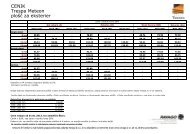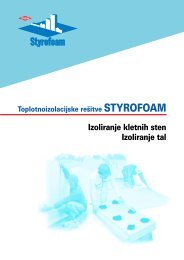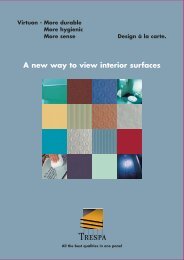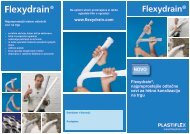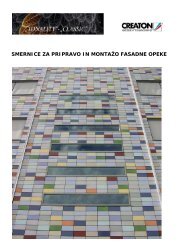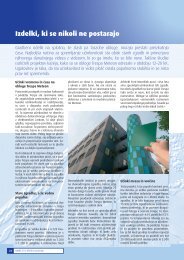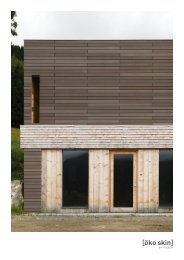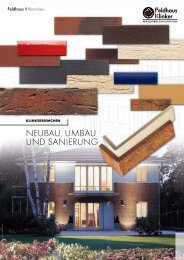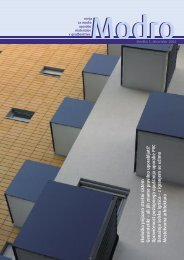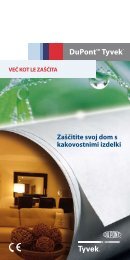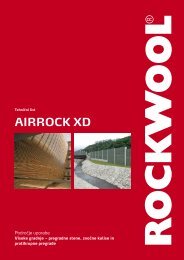Fibre C - Ravago
Fibre C - Ravago
Fibre C - Ravago
Create successful ePaper yourself
Turn your PDF publications into a flip-book with our unique Google optimized e-Paper software.
Life Cycle Assessment<br />
Objective sustainability<br />
The methodology of the life cycle assessment was developed to<br />
achieve an objective evaluation. It is regulated in the Norm DIN EN<br />
ISO 14040 and has been used for this study. As a result, the ecological<br />
choice of building materials can be based on scientific findings.<br />
Primary Energy (PeI ne)<br />
MJ/m²<br />
+ 353%<br />
Material<br />
All material and energy contributions of the individual processes<br />
of manufacture and use of a cladding panel have been balanced in<br />
the process. These include the production of resources, the energy<br />
supply, the manufacture of the products required, the provision<br />
of the infrastructure, transport services and the use and disposal<br />
of the particular products. As part of the impact assessment, the<br />
emissions in air, water and soil were calculated and summarised<br />
them using equivalence factors into the following 3 impact categories<br />
(OI3 Index):<br />
• Primary energy content not renewable (PEI ne)<br />
• Global warming (GWP)<br />
• Acidification (AP)<br />
800<br />
600<br />
400<br />
200<br />
0<br />
202<br />
+ 72%<br />
347<br />
+ 89%<br />
381<br />
914<br />
fibreC Aluminium <strong>Fibre</strong> Cement HPL<br />
Primary energy content not renewable (PeI ne)<br />
The ”Primary energy content not renewable” is calculated from the<br />
upper calorific value of all those non-renewable energy resources,<br />
used in the manufacturing chain of the product.<br />
Global Warming (GwP)<br />
kgCO 2<br />
eq/m²<br />
Global warming (GwP)<br />
The greenhouse potential GWP (Global Warming Potential) describes<br />
the contribution of a substance to the green house effect relative<br />
to the contribution of a similar amount of carbon dioxide.<br />
30<br />
20<br />
+ 77%<br />
+ 97%<br />
+ 64%<br />
Acidification (AP)<br />
Acidification is caused mainly by the interaction of nitrogen oxide-<br />
(NOx) and Sulphur dioxide gases (SO 2<br />
) with other components in the<br />
air. The Acidification Potential (AP) is a measure of the tendency of a<br />
component to become acidified.<br />
10<br />
14,0<br />
24,7<br />
27,6<br />
22,9<br />
Source: www.ibo.at<br />
0<br />
fibreC Aluminium <strong>Fibre</strong> Cement HPL<br />
IBO Test certificate for ecologically recommendable product<br />
Comparisons show that the production of fibreC, unlike other cladding<br />
materials, is completed in a very ecologically sound manner.<br />
The manufacture of fibreC has 49% less greenhouse potential than<br />
in fiber cement panels and aluminium sheeting. With its excellent<br />
eco profile, fibreC consumes 78% less primary energy than high<br />
pressure laminates.<br />
The IBO test certificate is regarded as a recognised and independent<br />
test seal, issued only to selected products that meet strict<br />
environmentally compatible and ecological criteria. It facilitates<br />
transparency and represents a reliable aid to decision-making for<br />
ecologically recommendable products. (Source: IBO Product test<br />
06/2009).<br />
Acidification (AP)<br />
kgSO 2<br />
eq/m²<br />
1<br />
0,5<br />
+ 195%<br />
+ 125%<br />
+ 3.045%<br />
1,258<br />
0<br />
0,04<br />
0,118 0,09<br />
fibreC Aluminium <strong>Fibre</strong> Cement HPL<br />
17



